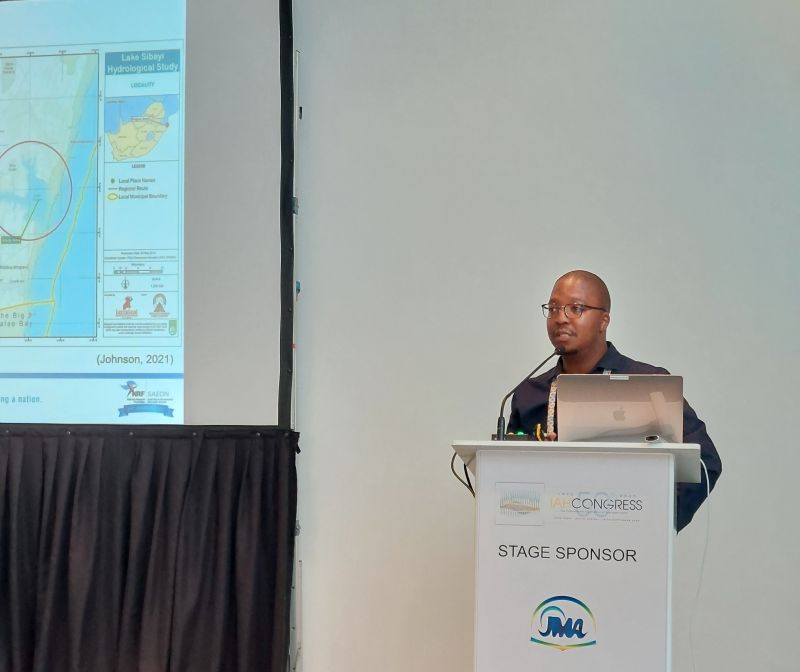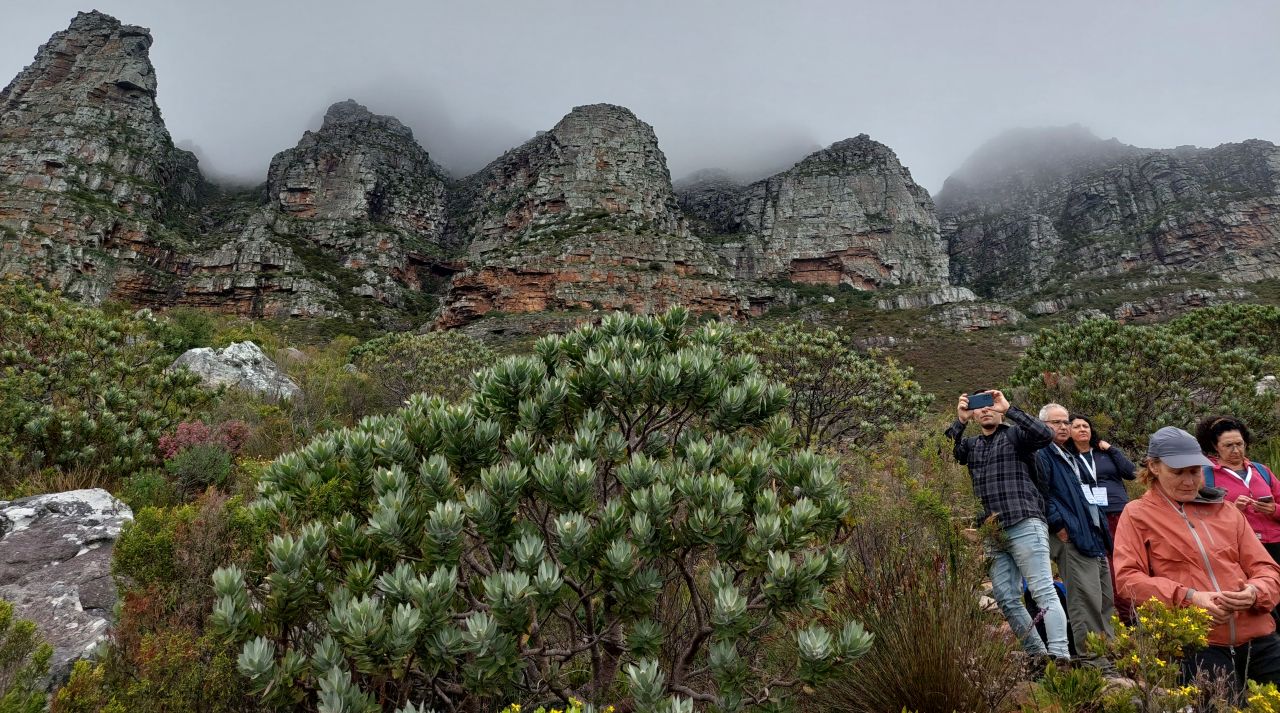eNews
#01 2024
Insights gained from my first international conference as a geohydrologist
By Mkholo Maseko, Junior Groundwater Hydrologist, Grasslands-Forests-Wetlands Node
A study determining the impacts of land uses on water resources in the Lake Sibaya catchment in northern KwaZulu-Natal revealed that eucalyptus plantations have contributed to an approximately two-metre drop in water levels in the catchment, in addition to the declining trend in water levels induced by climate. I formed part of an interdisciplinary team in a Water Research Commission (WRC)-funded project looking at the socioeconomic implications/consequences of different land uses on water resources for drinking, sanitation and sustaining wildlife in the area, including hippos and crocodiles.
I became interested in groundwater modelling at the end of my honours year after reading a paper on its use in the Middle East where groundwater is the primary source of water. I then asked myself which areas in South Africa were groundwater dependent and how many of these groundwater modelling studies have been conducted for those areas?
Having a hydrology background, I was surprised to discover the wide use and relevance of groundwater modelling in South Africa, especially in KwaZulu-Natal. When I started my MSc at the University of KwaZulu-Natal, I was privileged to have a groundwater modelling veteran, retired Professor Bruce Kelbe, as my mentor while working on the WRC study.
I had to immerse myself in the language and thinking of hydrogeologists to become a geohydrologist and to start updating a groundwater model previously developed by Prof Kelbe for the Lake Sibaya site, which was required for the project. The SAEON Grasslands Node, in collaboration with JG Afrika and the Department of Water and Sanitation (DWS), has been investing in a monitoring network for the Lake Sibaya area which took place almost at the same time questions were arising about how the people living in the area and dependent on the lake and groundwater catchment could sustain themselves as lake levels continued to decline past set and recommended ecological reserves.
The groundwater modelling component of the WRC project not only answered the question of the relative attribution of forestry and climate to lake level declines posed by the DWS 2015 Reserve Determination Report, but also provided plausible scenarios of how the system will behave in the future if land uses remained as they currently were, or if they were altered.
After completing my MSc towards mid-2023, I joined the Grasslands Node as a junior groundwater hydrologist, with the finalisation of the groundwater model to run the various plausible scenarios as my primary focus. The support I have received from the Grasslands team, more so the node coordinator Sue van Rensburg, has contributed to the development of my professional skills. It has also boosted my confidence in communicating my research more effectively and to see the potential for innovation within my field of study.
The conference kicked off with various speakers in the opening session, including the Minister of Water and Sanitation, Mr Senzo Mchunu
Mkholo Maseko, a junior groundwater hydrologist at the Grasslands Node, presenting on the ongoing Water Research Commission study aimed at societal impact
Presenting at international conference
In September 2023, I attended my first international conference, the International Association of Hydrogeologists 50th Congress, hosted at the Cape Town International Convention Centre arena. The conference kicked off with various speakers in the opening session, including the Minister of Water and Sanitation, Mr Senzo Mchunu. Mr Mchunu told delegates that, growing up, he wanted to be a doctor so that he could fix people, then he came to realise that doctors do not fix people, they make them feel better. When he became a water scientist, he was also able to make people feel better.
With those words in mind, I presented on the ongoing WRC study aimed at societal impact, which was well-received. Questions (or rather concerns) were posed by audience members about the implications of these declines on water supply into the future. Many wanted to know whether future climate projections indicated possibilities for this situation to turn around.
The conference featured presentations showcasing a range of disciplines from across the globe – from hydro-geochemistry, geophysics and groundwater modelling all the way to isotope- and other process-based geohydrology studies.
An innovative method that I was introduced to and would like to bring to the Grasslands Node is the use of groundwater level and barometric pressure loggers to estimate the hydrogeological and hydro-geomechanical properties of the aquifers found in the Lake Sibaya area. Aquifer properties have been a limiting factor in groundwater modelling studies throughout the world and the northern KwaZulu-Natal aquifer system is no exception.
Other studies presented on included the use of aquifers for remediation approaches by using injection wells where clean water is pumped into the aquifer instead of being pumped out. There were also presentations on devices that are still in the development phase, such as a probe that will provide real-time measurements of groundwater flow direction and speed, as well as devices for geophysical surveys and geochemical analysis.
Delegates had ample opportunity to network with hydrogeology professionals during a 12-km hike up Table Mountain and across the Table Mountain dams on the Monday before the conference (Photo: Mkholo Maseko)
Inspiring hike up Table Mountain
Getting through the conference programme after a 12-km hike up Table Mountain and across the Table Mountain dams on the Monday before the conference was a challenge. However, having different hydrogeology professionals out in the field with us allowed for easy networking. We learned more about what different hydrogeologists in different countries are doing and how their innovative ideas, together with our own, can be applied to improve our studies and have greater societal impact.
These interactions solidified my aspirations of growing as a groundwater modeller and gave me a near-future goal of developing a model that can aid decision-making on bulk water supply and contaminant transport. I hope to develop this model within the context of the Lake Sibaya area as agricultural industries are starting to take an interest, such as a large-scale cassava farm which is being developed in the area.
The model will build on the outcomes of the current ongoing WRC study which is assessing the economic viability and water-conserving potential of several alternative scenarios to eucalyptus forestry. We are currently testing dryland crops, irrigated crops, macadamia and marula, and with this model we could also look at the potential of supplying water for the agricultural produce post-harvesting factories.
If you would like to know more about the WRC project and the groundwater modelling work, watch these seminars on YouTube:
https://youtu.be/CoFv-dambX8?feature=shared (WRC project)
https://youtu.be/Cm8a1OCkbOo?feature=shared (Groundwater modelling component of WRC project [disclosure: results presented in this seminar are outdated and differ slightly from the current results]).
“We learned more about what different hydrogeologists in different countries are doing and how their innovative ideas, together with our own, can be applied to improve our studies and have greater societal impact.” ~ Mkholo Maseko







